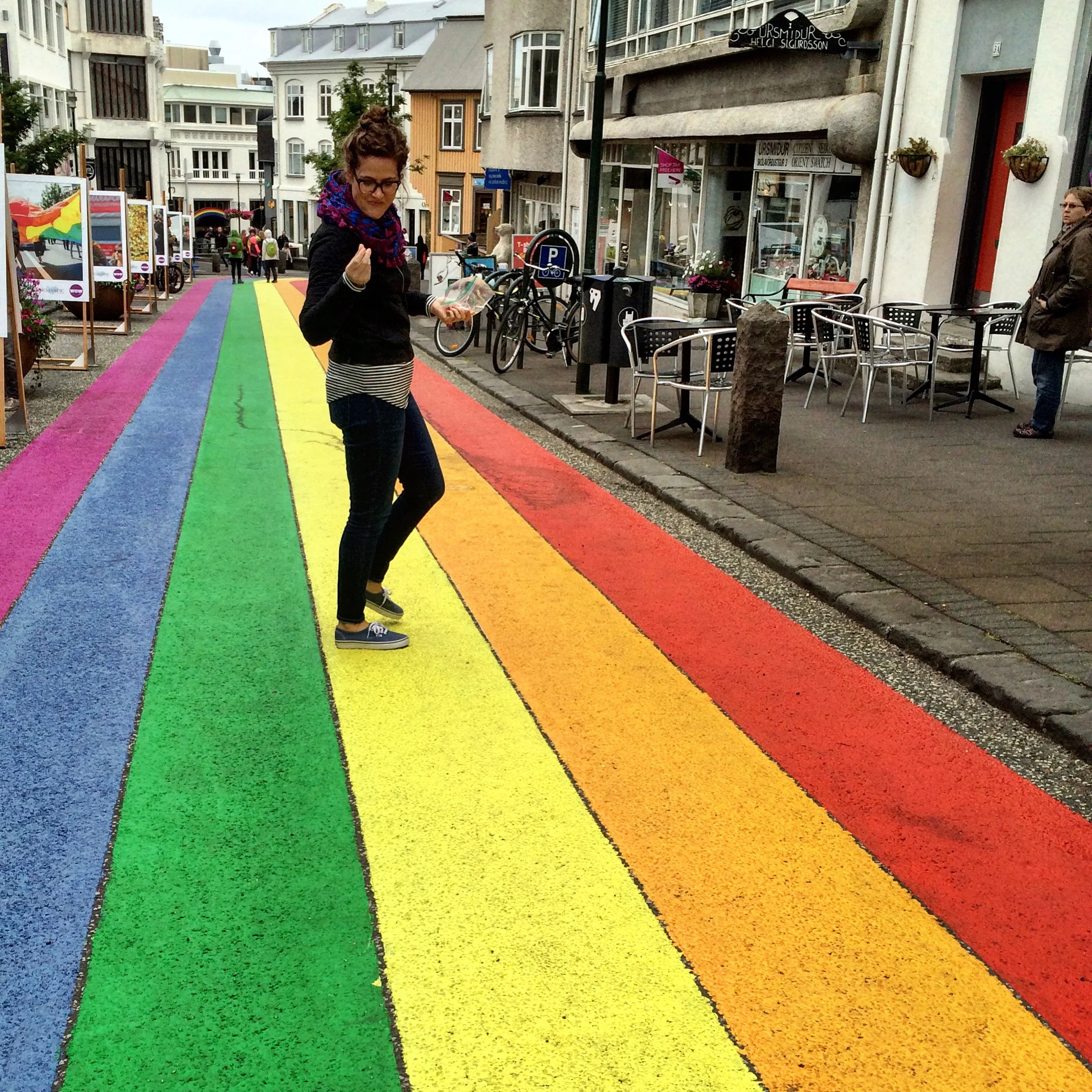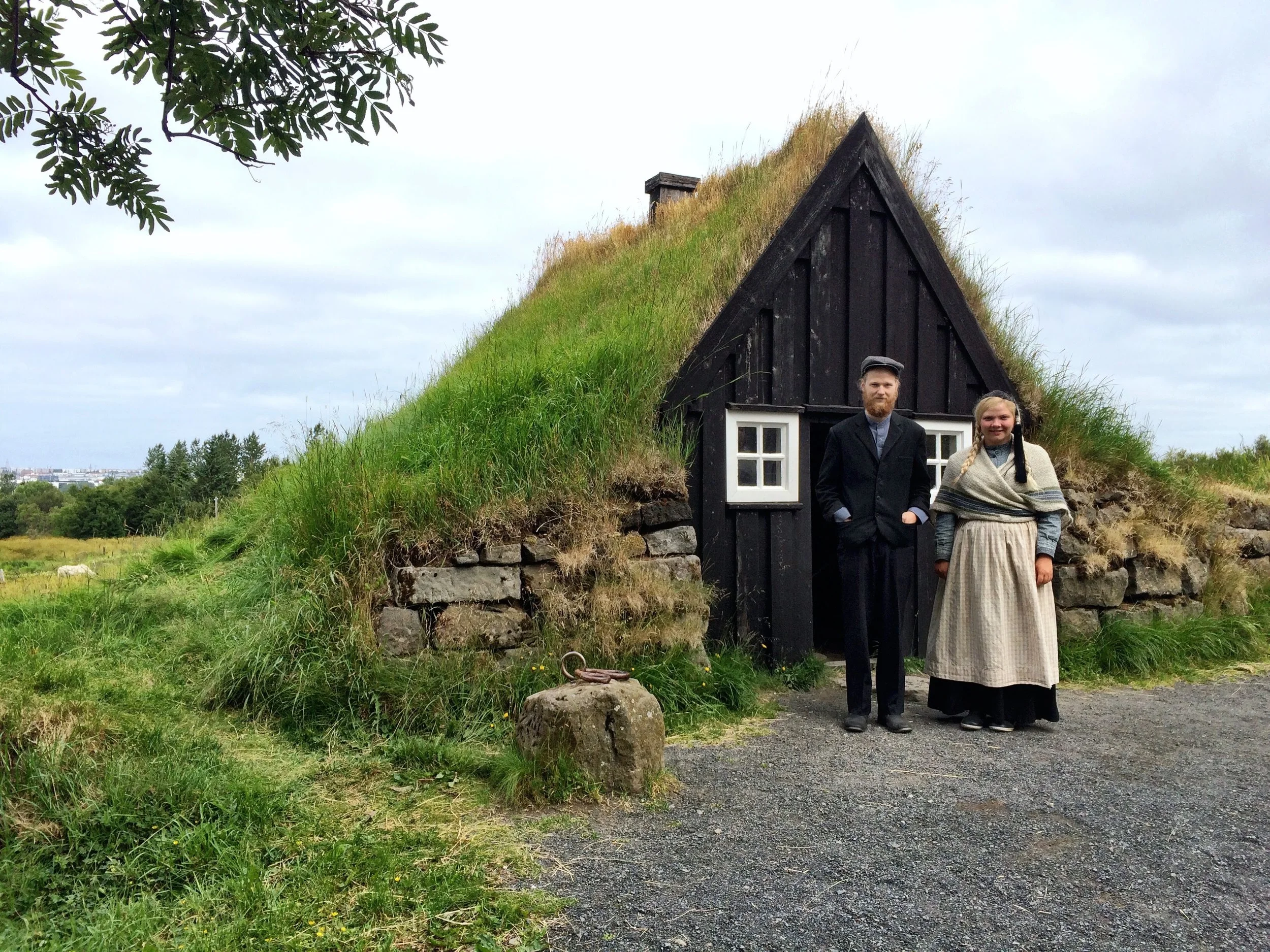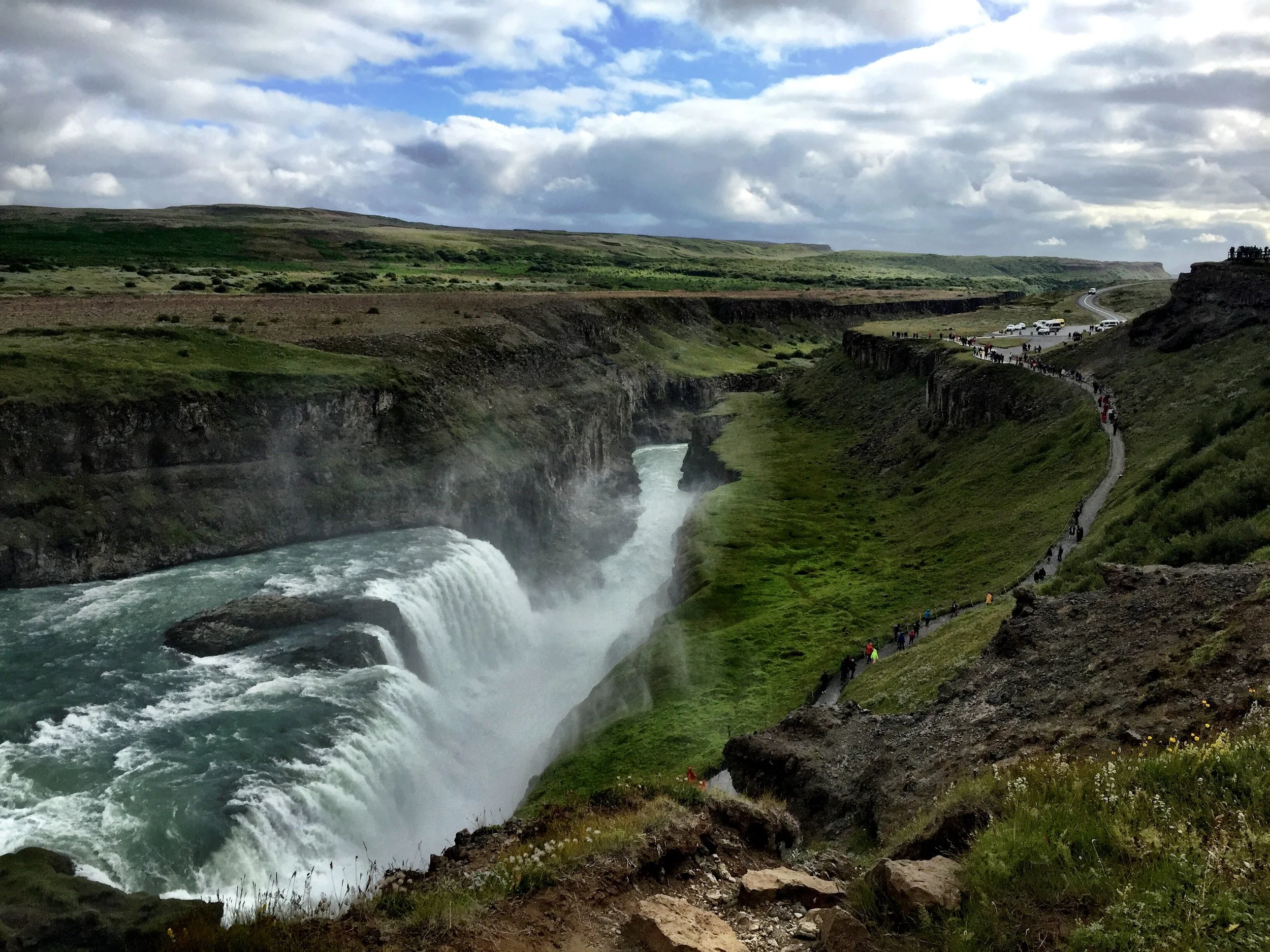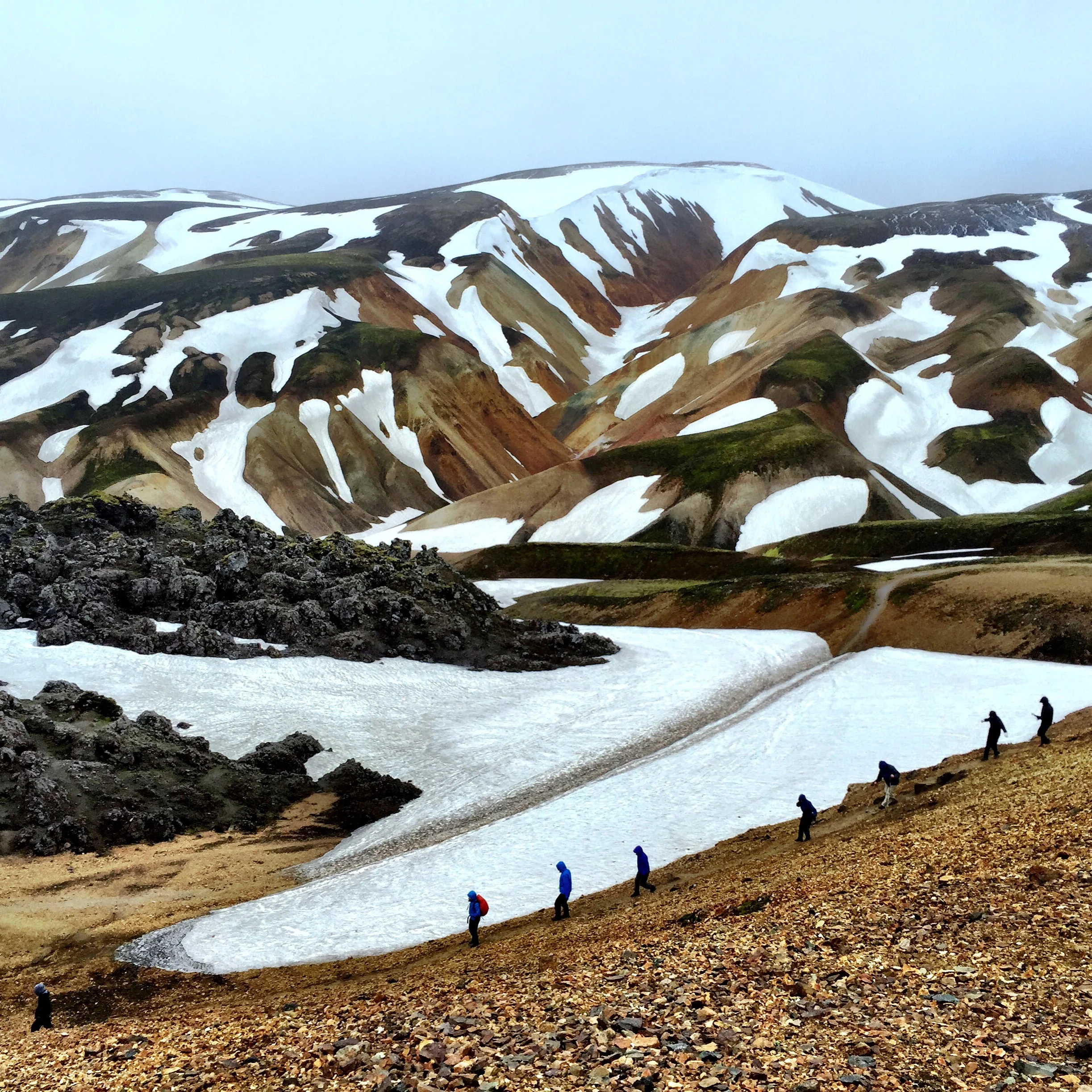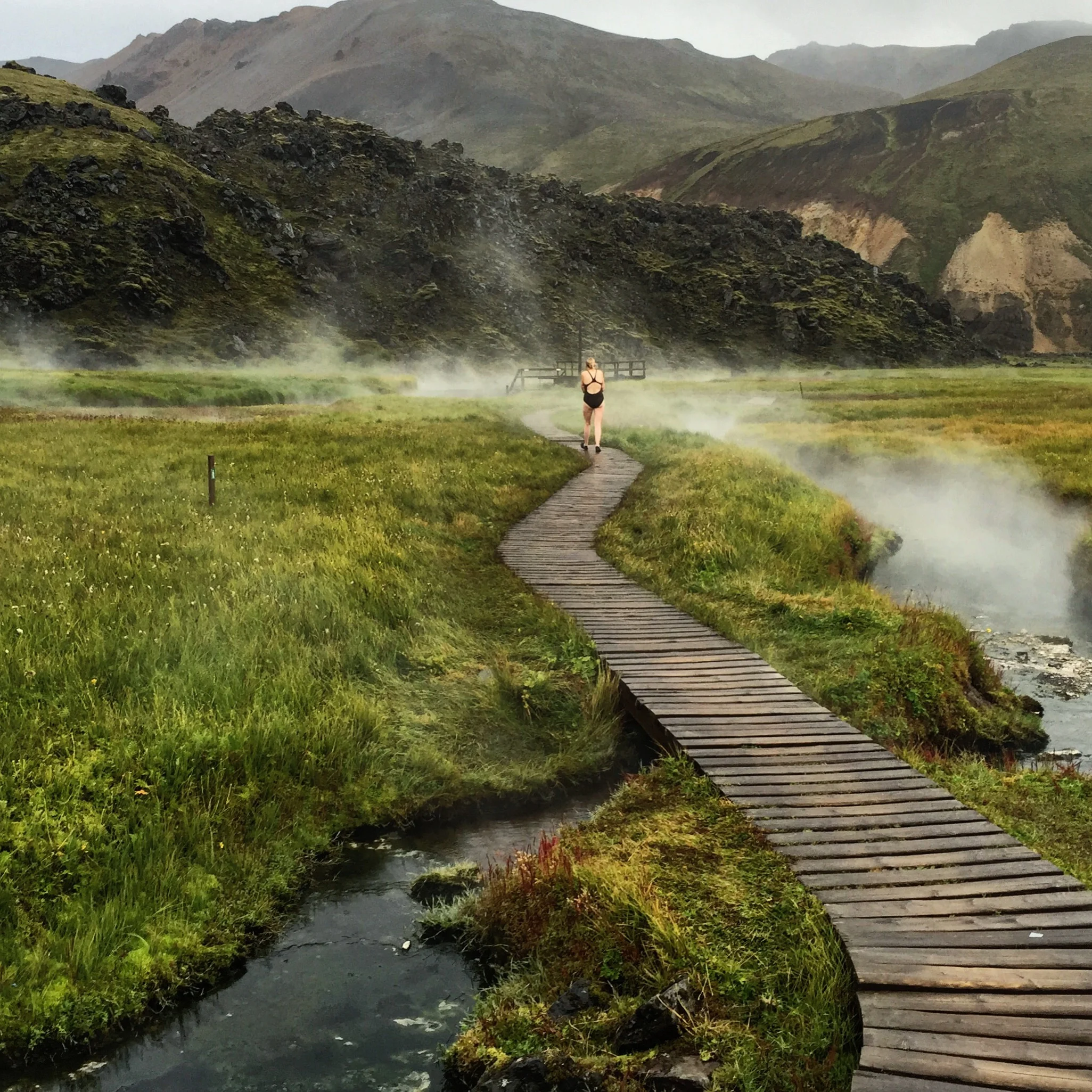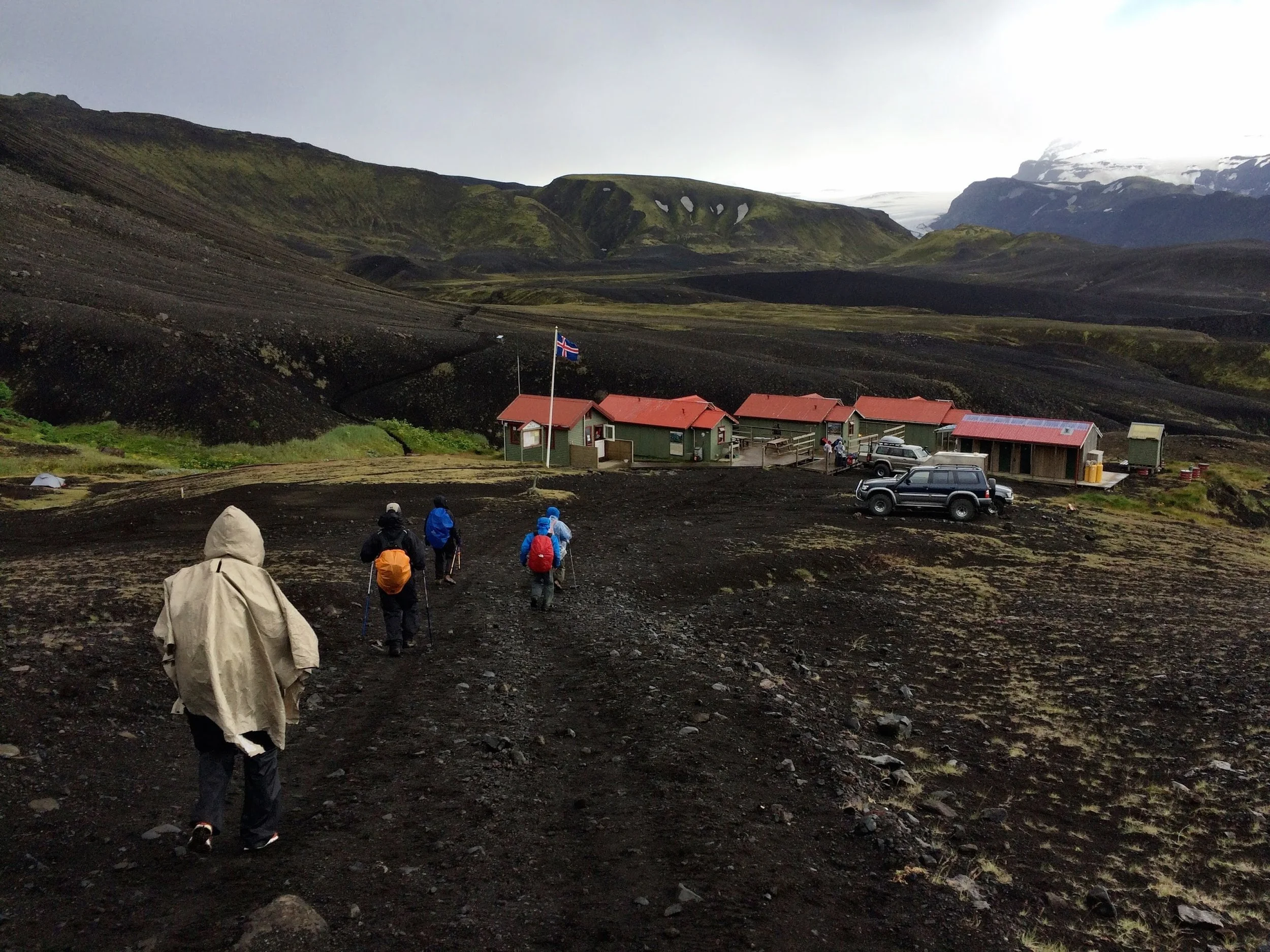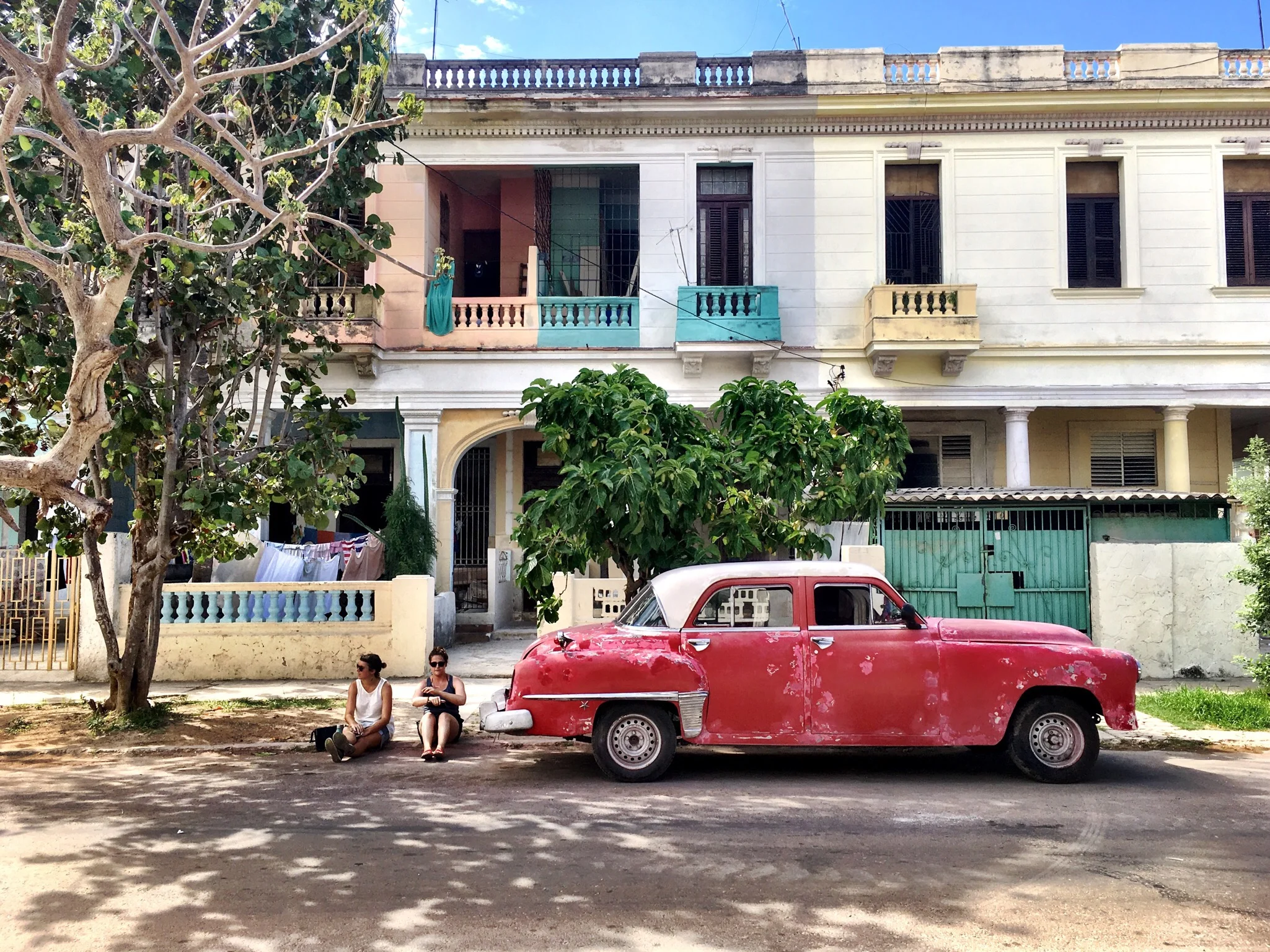Iceland | August 2015
IN FLIGHT
Travel time: 14 hours, 55 minutes (LAX to JFK to KEF)
Miles covered: 10,136 (roundtrip)
Movies consumed: 8 (Top Five, St. Vincent, True Story, Independence Day, The Longest Ride, Danny Collins, Into the Woods, Mamma Mia)
Hours slept: not nearly enough
POST FLIGHT
Travel time: 8 days
Miles covered: an abbreviated 19 (on foot)
Hot dogs consumed: not nearly enough
Currency: ISK (Icelandic Krona), 1 USD = 130 ISK, as of 2016
Prologue:
There’s a reason the Icelandic tourism industry has increased some twenty percent each year since 2010. The country is magical, unlike anything I have ever seen. It’s no wonder much of HBO’s Games of Thrones is filmed in the land of fire and ice. The scenery – from bleak black lava fields to lush green mountains to blindingly white glacier covered volcanoes – is rife with any number of unnaturally natural disasters. The sense of danger and adventure hearkens to a time when dragons flew the unfriendly skies and the earth could open up, spewing hot spring water or liquid magma at any moment. And often still does.
When I visited in the summer of 2015, the population was approximately 330,000 people, with two-thirds calling the capital city of Reykjavik their home. The natives are very helpful and friendly and, of course, speak impeccable English. Among its other inhabitants are hearty horses, sheep – that produce wool the country is famous for – elves, trolls, and hidden people. Uprooting or annoying the mystical creatures living all over the island is thought to carry a heavy price, so human inhabitants will do almost anything to avoid getting on their bad side. Road construction has been diverted and environmental protests mounted in an effort to keep the peace. There is even an school – the aptly named Elf School – single-mindedly devoted to the study of these hidden peoples.
Icelanders live in a world where invisible forces around them shape their lives. Perhaps mysticism, like religion for some, was a way to combat the harsh conditions of life on the island. Icelanders have also developed a dry sense of humor and great pride in their country. In 1955, Halldór Laxness was awarded the Nobel Prize in Literature. To this day he remains the only Icelandic Nobel laureate; however, as Icelanders are quick to jokingly point out, they continue to hold the title of most Nobel Prize winners per capita. Turns out, in a country of 330,000, Iceland tops the list per capita in a great many categories.
Chapter One:
Bright-eyed and bushy-tailed, we depart Los Angeles at 11:15 a.m. After a brief stopover at Kennedy, we continue to Keflavik International Airport in Iceland, arriving the following morning. The famous Blue Lagoon is strategically located between Reykjavik and the airport, so it is recommended (if you so choose) that you visit either on your way to of from the airport. After a long travel day, we opted to visit as soon as we arrived in Iceland. The tour (we booked the bus transfer and admission through Reykjavik Excursions) provided transportation from the airport to the Lagoon and finally to our accommodations in Reykjavik. After withdrawing currency and going through customs (an extremely painless process seeing as KEF was voted best airport in Europe according to Airports Council International’s annual survey in 2014) we met our bus outside. The very touristy Lagoon experience has its detractors, but the facilities are beautiful, the staff friendly and organized, and the water warm. You are able to stow your luggage in a building adjacent to the parking lot. Take only what you really need – cash or credit card, old bathing suit (the silica in the water may stain or damage your suit), sandals, and towel (available for rent if you do not have your own). During the check-in process you are given a wristband and ushered to the futuristic locker rooms, where you can change and stow your personal belongings. They ask you to rinse off (completely nude) before taking a dip. The showers are equipped with shampoo and conditioner. You may want to apply leave-in conditioner and avoid getting your hair wet in the lagoon. The geothermal seawater can make hair stiff and difficult to manage. As for that wristband you received upon arrival: it serves as a locker key and payment method for any drinks (both alcoholic and non) you have while relaxing in the warm murky blue waters. Like a Lannister, you pay your debts when checking out. We went with the standard no-frills package priced at fifty euro per person. But, obviously, they offer first class options that include robes, drinks, and massages. Whichever experience you choose, pre-booking is required and can be done online. The website also answers frequently asked questions. As for taking advantage of the photogenic scenery, we saw lots of bathers with waterproof phone cases hanging on lanyards around their necks. If you forgo the lifeproof case, a ziploc bag works well in a pinch. We enjoyed beverages at the swim-up bar and silica mud masks the spa is famous for.
The facilities include a gift shop and convenience store/cafe onsite. You can purchase snacks and drinks to consume on the grounds. After having enjoyed all that the Blue Lagoon has to offer, you can either continue to Reykjavik or be dropped off at KEF. Buses to both KEF and Reykjavik depart nearly every hour.
Through our booking, we requested a drop off directly at our accommodations. There are numerous airbnb, hostel and hotel options. Our airbnb was a cozy two-bedroom centrally located between Hallgrímskirkja, the largest church in Iceland, and Laugavegur, the main commercial thoroughfare named for the famous route on which we would later trek. We napped, explored the city and its architecture, various murals and art installations, and dined at Snaps, an adorable French bistro just off the beaten path.
Just as one would expect in a city that spends half the year shrouded in darkness, Reykjavik has a bustling nightlife. However, there are strict rules about the sale of alcohol. People under the age of 20 are not allowed to buy alcohol of any kind. The only stores that are allowed to sell alcohol are government-owned alcohol stores called Vínbúðin. The stores do not keep long hours, generally open from 11:00 a.m. to 6:00 p.m. They are closed on Sundays. The most accessible store for people staying in Reykjavik city center is the store on Austurstræti 10a. In this same vein, I’m a proponent of finding a local grocery store and stocking up on fresh produce, breakfast items, and sandwich fixings. Bónus is probably the best known budget store in Iceland and usually considered the “cheapest.” The selection is not great but should fulfill your basic food needs and save some money.
Chapter Two:
Our afternoon is booked, but we have the morning to ourselves. From the city center (Lækjartorg/MR bus stop located at the corner of Lækjargata and Amtmannsstigur), we took bus route 12 from Skeljanes to Árbær, the open air folk museum, comprised of 20 buildings (mostly relocated from central Reykjavik) forming a town square, village, and farm. Árbær (think Colonial Williamsburg meets Iceland) gives a sense of the architecture and way of life of the past. Pull the cord for the Árbæjarsafn stop, just a short walk to the museum across the street, use the underpass. The return bus stop is located on the museum side of the street. The bus ride takes about 40 minutes with all the local stops and costs 400 ISK per person each way. The bus driver can only accept exact fare. June through August, the museum is open from 10:00 a.m. to 5:00 p.m. During the winter season, September to May, visits are by guided tour only. Admission is 1,400 ISK each. We arrived right as it opened, just in time to see the reenactors scurrying to their respective historical stations. You really only need an hour to explore the grounds and stage Icelandic Gothic photoshoots.
We worked up quite an appetite revisiting the past, and it was time to embrace the unofficial national food of the present. Hot dogs. Bæjarins beztu pylsur is the most popular spot – citing Bill Clinton and Madonna as patrons – and does not disappoint. Located right across the street from the Radisson Blu 1919 Hotel, the stand is easy to miss, but should not be. I recommend ordering this local delicacy with all the fixings – raw onions, crispy fried onions, ketchup, sweet brown mustard, and remoulade. The stand is cash only. The line gets long but moves quickly.
Wonderfully fortified, we were ready for the Golden Circle tour. The tour company picked us up at our airbnb and drove us to the three main attractions: Geysir geothermal area, Gullfoss Waterfall and Thingvellir National Park, site of tectonic plates and first parliament. Iceland straddles the mid-Atlantic ridge, where the Eurasian and the North American tectonic plates meet. The plates are very slowly pulling apart, allowing heat from the Earth’s core to escape. More rarely, lava emerges. Less dramatically, this heat is escaping constantly through geysers, making hot springs a common feature.
I would have preferred to spend less time at the tectonic plates, and more at Gullfoss. You can get quite close to the falls. In my opinion, the best view is from the path above, looking down on the falls. Each site on the tour had the requisite gift shop and public restrooms.
Like most things in Iceland, the restrooms are not free. The entrance is monitored with turnstiles that accept credit cards, granting access to the facilities, only after you’ve swiped your card. Our tour bus dropped us off back at our accommodations. Tonight, we dined on the Laugavegur strip at Gló. The portions are generous, health-conscious, and on display for all you visual learners. The fresh seasonal menu changes daily.
Chapter Three:
During one of many strolls down the main Laugavegur drag, we discovered Bakarí Sandholt – a great bakery and cafe with dine in and takeaway options. Before our tour of Iceland’s south coast, we bought pre-made sandwiches to pack for lunch. We embarked on the South Coast Tour and were abruptly introduced to the diverse, unpredictable weather of Iceland. Until today, the weather had been colder than I expected for summer (prior to Iceland, the coldest winter I ever spent was summer in San Francisco), but at least clear and sunny. Today’s plan was to take a bus ride along the south coast of the island, chasing scenic waterfalls (Seljalandsfoss and Skogafoss) and black sand beaches (Reynisfjara) along the way. Seljalandsfoss is spectacular. You can actually walk behind this magnificent waterfall. Bring a poncho or waterproof jacket. You will get wet. For us, it was impossible to differentiate the waterfall’s spray from the rain showers.
The buses are quite comfortable (I never met one I didn’t fall asleep on) and most have free wifi. Skogafoss (foss translates to waterfall in Icelandic) is amazing, too. This waterfall features a trail alongside, so after climbing some 400 steps you can take in the view from above. We were rushed through Skogafoss and unable to ascend the stairs.
The buses are less tour, more shuttle, with a schedule to keep. For our tour, the final destination was to be the Jökulsárlón Glacier Lagoon. To save time and avoid retracing our steps, the tour included a one-way return flight from Jökulsárlón to Reykjavik. As a result of the storm, the tour was unable to guarantee a flight back that night. It is their policy to provide overnight accommodations in case of such an emergency. However, our four-day backpacking trek – the main event, the crème de la crème – was departing early the following morning and as much as we wanted to see and sail the lagoon, we just could not risk a delayed or cancelled flight stranding us in Jökulsárlón. Instead, we went as far as Vik (the southernmost village in Iceland, surrounded by beautiful valleys, beaches, cliffs and mountains, our view unfortunately obscured by the storm), before taking the bus back to the city. Keep in mind, we are picking up and dropping off passengers at each destination, making it entirely possible to take this bus for just one leg of the journey. You are able pay in cash as you board. I’m eager to return to Iceland for a more DIY backpacking trip.
This force majeure was disappointing, but the truncated tour did afford us the opportunity to re-evaluate our supplies and purchase much needed rain gear for the journey ahead. At a store on Laugavegur, we found the most essential and unflattering rain suits in all the land. Iceland incentivizes free enterprise by offering tax refunds on goods purchased in the country by non-residents. You can redeem the 10% refund at the airport before you depart. Proceed to VAT, take a number, submit the paperwork (provided by the store where you made purchase), your credit card used for purchase, merchandise receipt, and the purchased item. You account will be credited within a couple weeks. That night we took away really delicious pizza from Eldsmidjan.
Chapter Four:
The storm rages on. Our four-day trek traditionally departs from Landmannalaugar, with the first night spent in Hrafntinnuskar. This particular mountain hut is the most remote, snowed in and inaccessible, as we began the drive to Landmannalaugar. Trekking season is mid-June to mid-September. But we quickly learned you cannot necessarily depend on the weather’s cooperation. The Icelandic people are all too familiar with changes in weather. The only souvenir more ubiquitous than wool sweaters are tee shirts exclaiming “Welcome to Iceland! If you don’t like the weather, just wait five minutes…” Icelanders do not get flustered. They do not take uncalculated risks. They adapt. Fortunately, our guide was able to find lodging for our entire crew (16 in total) at hut zero in Landmannalaugar. The close quarters featured eight pairs of bunks lining each wall and a few picnic tables and benches in the corner. Soaked gear hung from the rafters; socks and gloves stuffed in the radiator. The hut had a separate kitchen/dining room and small living room area. This hut, normally the jumping off point and not an overnight stay, featured a wonderful natural geothermal hot spring that we were able to take advantage of to thaw our freezing bodies.
Our wonderful guide, Maggie, led a moderate day hike of the area. Despite missing out on 7.5 miles and the obsidian desert, we were still able to enjoy the colorful mountains and steaming hot springs of Landmannalaugar. Maggie (apparently one of the better chefs in the company) prepared a delicious dinner of salmon pasta. The tour does accommodate allergies and dietary restrictions. With a modified day one under our hip belts, we turned in, trying our darnedest to sleep amidst the symphonic range of thirty-two people snoring.
Chapter Five:
The treacherous conditions at Hrafntinnusker became the stuff of legend. We heard tales of a lost and then found solo backpacker. Newlyweds nearly blown away by blustery winds. So it was for the best when it was decided to skip hut one entirely and drive directly to hut two. Even the protection of the all-wheel drive bus did not make for a less perilous journey. We encountered two raging river crossings, with all the exhilaration of the Universal Studios tram flood, mixed with (for me) genuine terror.
The two-storied lake hut at Alftavatn was the swankiest, with more private rooms housing two to five guests. As is customary, all the toilets, sinks, and showers are located in a separate detached building. So you have to (rain)suit up and brave the weather conditions each time you need to use the facilities. The water closets provide toilet paper, but no paper towels.
In an effort to mitigate our cabin fever, Maggie led another optional day hike around the lake. We accepted, relishing the chance to flaunt our beach bodies in shapeless rainwear. Most of the afternoon was spent drying our clothes and ourselves – until, for a few miraculous minutes, the sky opened up, and I rushed outside to feel the warm sun on my back and catch a glimpse of how different this experience would be under drier circumstances. Don’t get me wrong, we were having a great time, taking advantage of every opportunity go outside and explore the scenery, no matter the weather. But we could not help envisioning ourselves basking on the black sand beach or playing cards at the outdoor picnic tables or the ease with which one could walk outside to the restrooms. Yet again, Maggie wowed us with her cooking – a warm and hearty lamb stew. And the freezing temperatures were good for one thing: our skyr (Icelandic yogurt) and berry dessert naturally chilled outside as we dined. Each day, the trekkers in our group took their turns as sous chefs and dishwashers. It’s important that you be proactive and offer to help. It quickly becomes clear who isn’t pulling their weight.
Chapter Six:
And so it begins. At last, we trek. The rains persisted, but the weather forecast and current conditions at hut three were promising enough for us to make our own way. Despite the inclement weather, our spirits were high. The mostly flat journey brings barren lava fields, mossy mountains (Botnar), bridges and streams. This hiking day included two notable river crossings. The first came shortly after leaving the hut. The idea is to hike up your bottom layers and change into a different pair of shoes. We would link arms between two or three people, depending on the water height and velocity, and ford the rushing river, Oregon trail style. Walk at an angle, with the flow of water. Hiking poles are very helpful for stability. I packed two pairs of sneakers – one for trekking and an old pair (discarded at the end of the trek) for river crossings. Because of the storm, neither pair was ever completely dry. I made it work but it was a logistical problem. I would suggest a nice pair of waterproof/gore-tex hiking boots and slip-on water shoes or sport sandals for the crossings. You don’t want to wear socks during the crossings. Once across, you can towel dry your legs and feet and put your hiking boots back on. Depending on the water height, you can either roll up your pants or switch into shorts. Some of our crossings were so deep, that we did away with pants altogether. Ponchos have great coverage. As a rule, pack out all garbage and fruit peels, pits, etc. Leave the land just as you found it. The natives (human and elf, alike) will be grateful.
Now that we are trekking, I should mention the unburdening of our luggage. Every day, an SUV would port our heavy luggage (clothes, sleeping bag, pillow, towel, whatever) from one hut to the next. As a “backpacker,” you are only responsible for a daypack containing lunch, water, camera, waterproof clothing, water shoes, etc. If you are traveling with a partner, you may only need one day pack for the two of you. You can decide among yourselves how to divide the labor.
After arriving at the hut in Emstrur and unloading the truck, we take an extracurricular hike around the surrounding the area. The Markarfljótsgljúfur Gorge, carved by the Markarfljót River, is absolutely…er…gorgeous.
Hut three is the smallest – just the one room with bunks along the walls, small kitchen at one end and long table in the center. The huts are fantastic, such a fun experience. We would hike until early afternoon and then have a lot of time to ourselves. Because of the weather (yes, it’s still raining) most people would rest or read or play card games in the hut.
Each location also offers campsites for the outdoorsy types. During those rainy days and nights, I did not envy them at all, coming into camp and never able to dry out. But, if the weather were different, I could see the appeal of sleeping out under those short Icelandic summer nights, never quite dark enough to see the stars or northern lights above. The huts can be booked in advance separate of a tour, but do require reservations. If you book a trekking tour, the company will handle hut accommodations. I believe the campsites are first come first served. Last I heard, you can camp anywhere along the trail, just don’t leave a trace. The campers are also allowed the use of the restroom/shower facilities at the huts. Some of the huts even feature outdoor grills. As far as I could tell, Emstrur had the most beautiful campsite, right along a little stream.
It had only been two energetic days so I opted out, but for those interested, you can splurge for a hot shower at huts zero, two or three. The showers cost $5 and the hot water lasts five minutes. Every morning, rain or shine, hike or bus, we would eat breakfast (oatmeal, fruit, coffee, tea), prepare sandwiches for lunch, pack and load our stuff into the truck, and clean the hut for the next day’s arrivals. I found it difficult to sleep in the huts. There are a lot of people on different schedules in a small space. And did I mention it’s light until 10:30 p.m.?! Being active during the day helps, but definitely pack an eye mask and earplugs. Sometimes those goodies are distributed inflight. Depending on your pharmacological philosophy, ZzzQuil or a prescription sleep aid would not be out of the question. Luckily, the call times are not too early. People were generally up and about by 7:00 a.m., but we would not leave until nine or so.
Chapter Seven:
For us, the second real trekking day is sadly the last. On this section we leave the barren highland and reach the green woods of the Þórsmörk region, named for the Nordic god. Shortly before the end of this leg, the torrential glacial river Pröngá has to be crossed. It’s the biggest obstacle of the long distance walk. After wet days the river swells to your hip and can be impossible to ford. By the hammer of Thor, we make it. The last stretch weaves through a dense birch tree forest, revealing Thorsmork from above.
And the place is bustling. The nearest site to downtown Reykjavik, it is the perfect starting or end point, depending on which direction you choose to hike. Busses are regularly traveling in and out. There are two huts, as well as chalets, campgrounds, a cafe and store, providing the first opportunity to purchase alcohol if you didn’t pack your own. I should mention that we travelled (in the SUV, of course) with our previously purchased boxed wine. It was nice to indulge in a glass of the fruit forward red blend after a long, cold day, but there wasn’t enough left to share and I felt bad flaunting my nightly apéritif. So instead I drank alone and secretly in my bunk. We were shuttled onto a bus back to the city and dropped off at the tourist information center, an excellent resource in downtown Reykjavik. The center has a friendly staff and free wifi. From there, we were able to “trek” to another airbnb on Grettisgata. For quick, easy dinner we had kebabs and fries from Durum.
There is an option for a six-day trek that continues to Skógar’s Fimmvorduhals hut. Most of the people in our group were in for the long haul. I think had we done the full four-day, it would have been enough. But after only trekking for two days, leaving the group at Thorsmork was bittersweet.
Our fellow trekkers were generally a great group. Thirteen English-speaking men and women aged 22 to late 60s, from Canada, New York, Florida, and California. The median was middle-aged. The real spry thrifty kids were going it alone. Perhaps the trend is changing, but it seemed that Iceland is not necessarily at the top of most people’s travel bucket lists. These trekkers had previously summited Fuji and Kilimanjaro, and hiked extensively in New Zealand and Canada. I found them to be great resources, both locally regarding Iceland must-see’s and more globally. We became this little family, looking out for each other, nursing injuries, sharing gear. Speaking of gear, I recommend waterproof boots, durable rain gear, water bottle or camelback (there is plenty of potable water), headlamp, gloves, hat or ear muff, quick-drying travel towel, and sleeping bag. My travel neck pillow pulled double-duty. The huts have electricity, but no outlets to charge cameras or phones. I would suggest investing in an Anker or Mophie portable charger (you don’t want to miss these photo opportunities).
At 1,100 euros, and taking into account that the price includes all meals, accommodations, and activities for four days, the trek is still very expensive. It was also one of the greatest experiences of my life. Now I want to trek all over the world – Italy, Cornwall, New Zealand. Last year, with limited backpacking experience and no knowledge of Iceland, I didn’t feel confident planning my own unguided tour. But it can definitely be done. We passed many unassisted hikers and backpackers along the way. The trail is well-traveled, probably more so now, although not particularly well marked. And some areas, like the lava fields, are expansive and indistinguishable. The distances between huts/campsites and degree of difficulty are moderate, spaced about seven to ten miles apart. Each hut has full-time onsite wardens to offer assistance.
Interlude:
Iceland is a geothermal and energy-efficient wonderland. Scalding water from the natural springs is cooled and pumped straight into the taps of homes, negating the need for hot water heating, and providing an explanation for why all hot showers smell distinctly of sulfur. Luckily, the smell doesn’t seem to stick with you. Spring water is also purified and cooled to provide ice cold and potable tap water. Icelanders take public pool culture very seriously – the Icelandic word for “Saturday” (laugardagur) means “pool day.” A geothermally heated pool is reliably found in every Icelandic village, some with water slides! Icelanders also resourcefully harnessed geothermal energy for agricultural purposes. In an effort to become self-sufficient and carbon neutral, they began growing potatoes, tomatoes, and cucumbers in geothermal greenhouses. Driving across the country, you will see one southern town, the hot springs capital of the world, populated with an impressive greenhouse, growing bananas. Throughout the world, commercially produced bananas are effectively clones of each other. With the world’s top banana export lacking genetic diversity, plagued by disease, and threatened with extinction, perhaps Iceland holds to key. Their bananas are frozen in time.
Iceland has innumerable incomparable sights. Unfortunately, you have to prioritize because you cannot do everything during the same time of year. Should you brave the icy winters, Aurora Borealis aka the northern lights shall be your reward. If the weather conditions are just right. For the best odds of seeing the lights, it is recommended you stay a minimum of seven nights. The northern lights usually tend to be very active for two to three nights, then low for four to five nights, in ongoing cycles. Apparently, the phenomenon occurs year-round, but the near-constant daylight of the summer months makes seeing them nearly impossible. Obviously, for us, summer won out, and I cannot personally speak to the wonder of the elusive northern lights.
Oh yeah, and Iceland is really expensive. But, if you’ve done enough research to find me, you already know that. To entice more tourists, Icelandair has an amazing promotion, offering a free stopover in Iceland (up to seven nights) on your way to or from Europe. We were unable to take advantage of this offering. At the time, the U.S. departures were limited to the pacific northwest, but they have since expanded to most major cities.
In 2008, Iceland suffered a major financial crisis. To bounce back, they devalued their currency and dropped their EU membership bid. And with a government bailout and tourism boom, they have fully recovered. You won’t be surprised to learn that I am not an economist and my grasp of these complicated issues is very limited (I just barely understood the crux of The Big Short). However, I worry about Iceland, though not fiscally. I worry about its psyche. I worry about the introduction of an invasive species to its untamed and unadulterated landscape and philosophy, about the throngs of temporary visitors and the infrastructure required to sustain them. And I paradoxically urge you to go just as soon as you can.




